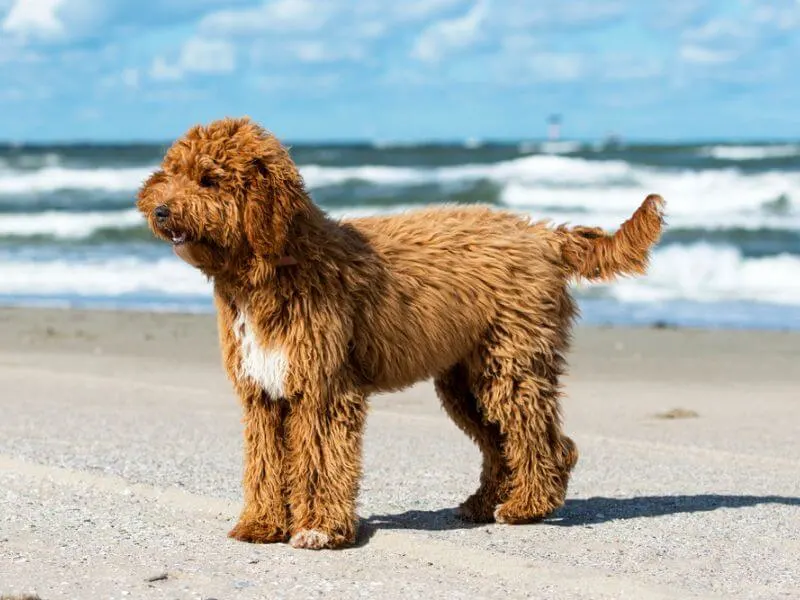
Table of Contents
- 1 The Irish Doodle Dog Breed
- 2 What is an Irish Doodle?
- 3 What is a mini Irish Doodle?
- 4 Is the Irish Doodle an Irish dog breed?
- 5 Irish Doodle Generations
- 6 F1 Irish Doodle
- 7 F1B Irish Doodle
- 8 Irish Setter Poodle Mix Characteristics
- 9 How much does an Irish Doodle weigh?
- 10 Irish Doodle Maintenance
- 11 How long do Irish Doodles live for?
- 12 Are Irish Doodles healthy?
- 13 What do Irish Doodles eat?
- 14 How much exercise do Irish Doodles need?
- 15 Is an Irish Doodle a smart dog?
- 16 Is it easy to train an Irish Doodle?
- 17 Irish Doodles Temperament and Personality
- 18 Irish Doodle Breeders
- 19 The Origin of the Irish Setter and Poodle Mix
- 20 History of the Irish Setter
- 21 History of Poodles
- 22 Irish Setter Poodle Mix
- 23 Native Irish Dog Breeds
The Irish Doodle Dog Breed
Irish Doodles are lovable, intelligent and active dogs that need plenty of both mental and physical stimulation to stay happy and healthy.
They are good natured, sociable dogs and need plenty of human company making them very suitable as family pets.
Discover more about the Irish Doodle from its breed characteristics and origins, to the pros and cons of owning an Irish Doodle in this in depth guide.
What is an Irish Doodle?
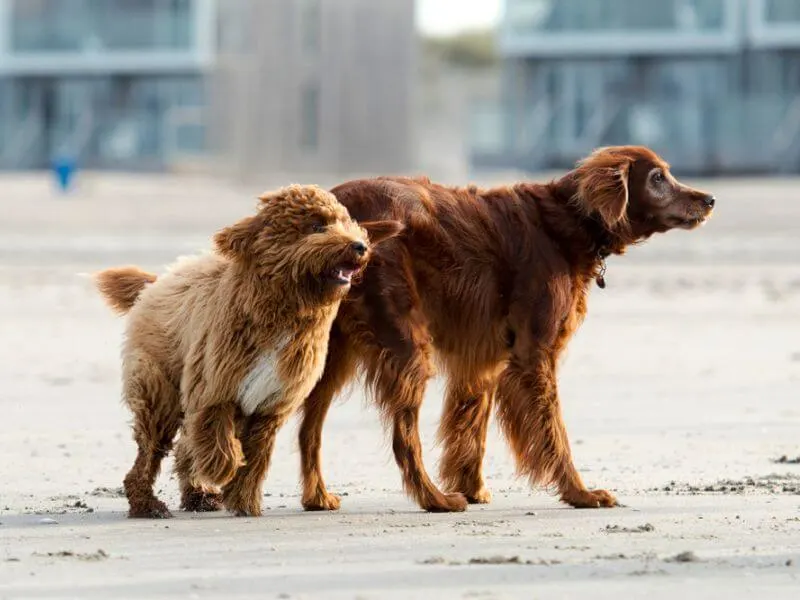
The Irish Doodle is a mix between a purebred Irish Setter and a purebred standard Poodle.
It is a hybrid designer breed that has only relatively recently been developed.
What is a mini Irish Doodle?
A mini Irish Doodle or miniature Irish Doodle is a cross between a purebred Irish Setter and a purebred miniature Poodle.
The Mini Irish Doodle size is considerably smaller than the Standard Irish Doodle.
Is the Irish Doodle an Irish dog breed?
No, while the Irish Doodle has Irish roots through its Irish Setter ancestry, the Irish Doodle is not an recognized Irish dog breed.
The Irish Kennel Club officially recognises 9 native Irish dog breeds, while the American Kennel Club recognizes 8 of these Irish dogs.
Find out more about the native Irish dog breeds in this Irish Dog Breed Guide.
Or about the individual Irish Dog Breeds in the links below:
- Irish Setter
- Irish Red and White Setter
- Irish Water Spaniel
- Irish Wolfhound
- Kerry Beagle
- Irish Terrier
- Kerry Blue Terrier
- Irish Soft Coated Wheaten Terrier
- Glen of Imaal Terrier
Irish Doodle Generations

Some people are not familiar with the Irish Doodle generations and are slightly confused by the F1, F1B and F2 terminology.
This is a rough introduction guide to cover the basics and help you understand the difference between the Irish Doodle generations.
What does the letter “F” in F1, F2 and F3 stand for?
The letter “F” denotes “filial hybrid” and is used to categorize the different generations.
For example, an F1 Irish Doodle is the result of crossing a purebred Irish Setter with a purebred Poodle.
If an F1 Irish Doodle is bred with another F1 Irish Doodle, the resulting puppies will be an F2 Irish Doodle (the second generation).
If two F2 Irish Doodles are bred together, the offspring will be F3. This is the simplest explanation, however in reality, it is a little more complicated.
Irish Doodle Desired Characteristics
The F1 Irish Doodles are a 50/50 genetic mix of their parents, although sometimes the offspring may look more similar to the parent Irish Setter or to the Poodle.
(Just think of the resemblances between parents and their children as a good example.)
Irish Doodle breeders often want dogs with particular types of characteristics.
Generally, people prefer dogs that don’t shed all that much as they are easier to manage and are more suitable for people with mild allergies.
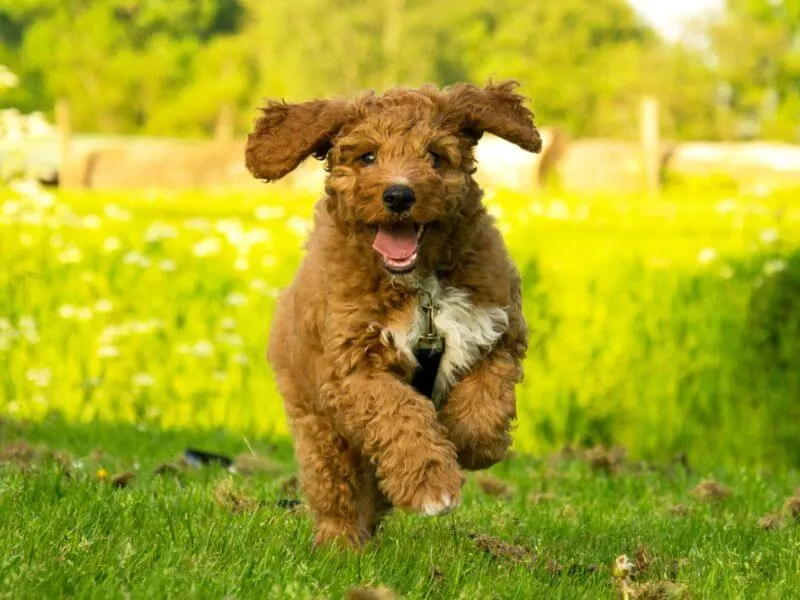
For this reason, breeders often opt to breed F1 Irish Doodles with a purebred Poodle to increase the likelihood that the coat type and perhaps other characteristics bear a closer resemblance to a Poodle than to an Irish Setter.
The Irish Setter breed sheds and is not hypoallergenic.
This generation of Irish Doodle is known as an F1B Irish Doodle and the letter “B” denotes that the generation was backcrossed to one of the parent breeds.
F1 Irish Doodle
Purebred Irish Setter x Purebred Poodle = F1 Irish Doodle
When a purebred Irish Setter is crossed with a Purebred Poodle, the resulting puppies are classified as F1 Irish Doodles.
These first generation mix dogs have roughly a genetic breakdown of 50% Irish Setter and 50% Poodle.
F1 Irish Doodles Appearance and Maintenance
The coat of a F1 Irish Doodle is usually wavy or even a little shaggy, but not typically curly.
It is not really possible to predict if a dog from this generation will be a low shedder or be suitable for people with allergies.
(It is only possible to really determine what the coat will be like when the Irish Doodle is fully mature.)
Many breeders claim that this is the healthiest generation of Irish Doodles, because they do not suffer from genetic conditions connected with the recessive genes of each parent breed.
Most of the Irish Doodles available from breeders are F1 Irish Doodles.
As they are usually more widespread, they are frequently less expensive than the other Irish Doodle generations.
F1B Irish Doodle
F1 Irish Doodle x Purebred Poodle = F1B Irish Doodle
A F1B Irish Doodle is the offspring of an F1 Irish Doodle bred, or in this case, “back crossed”, to a Poodle.
The rough breakdown of the genetic makeup of this Irish Doodle puppy is then 25% Irish Setter and 75% Poodle.
F1B Irish Doodle Appearance and Maintenance
In terms of appearance, these dogs tend to have curlier coats than the F1 generation of Irish Doodles.
While their coats generally need more care, they shed very little and are more similar to that of a Poodle.
This makes this generation of Irish Doodle more appealing for people who have mild allergy symptoms.
This short guide just covers the basics of Irish Doodle generations.
There are of course multiple other generations including the F1BB Irish Doodle (resulting from a F1B Irish Doodle x Purebred Poodle Cross), F2B Irish Doodle (F2 Irish Doodle x purebred Poodle cross) or a multigen Irish Doodle (multigenerational that involves crosses with F3 and beyond).
These are beyond the scope of this article.
If you want to delve deeper into the genetics and the principles of inheritance behind Irish Doodle generations, then this article may be worth reading.
Irish Setter Poodle Mix Characteristics
How tall is an Irish Doodle?

Standard Irish Doodles are medium sized dogs roughly 45-68 cm (18-27 inches) in height when fully grown (ca. 18 months).
These dogs are the result of crossing an Irish Setter with a Standard Poodle.
(Tip for Irish Doodle Full Grown: If you are wondering about the future size of your Irish Doodle puppy, it is good to ask the breeder about the size of the dog’s parents.)
How tall is a Mini Irish Doodle?
The size of a full grown Irish Doodle depends on its genetics that it inherited from its parents.
When a mini Poodle rather than a standard Poodle is crossed with an Irish Setter the resulting Mini Irish Doodles are typically 38-56 cm (15-22 inches) in height when fully mature at around (7-12 months).
How much does an Irish Doodle weigh?
A Standard Irish Doodle adult weighs in at around 20-29 kg (45-65 pounds), while a smaller Mini Irish Doodle adult weighs between 9-18 kg (20-40 pounds).
What does an Irish Doodle look like?
An Irish Doodle can have a wavy or curly coat, depending on the traits that the Irish Doodle inherits from its parents.
The F1 Irish Doodles are typically not as curly as the F1B Irish Doodle generation for example.
Some dogs can have long hair that will need to be trimmed every so often to keep it in shape.
The coat of an Irish Doodle can come in a variety of different colors. Apricot, red and black are the most common Irish Doodle colors.
Some dogs also have white patches, these are often slightly more desirable and therefore expensive.
While some Irish Doodles have broader faces, similar to Irish Setters, others tend to look more like Poodles with narrower features.
Their eyes are usually oval or almond shaped and are a medium to kard brown color.
Irish Doodle Maintenance
Irish Doodles require the same general maintenance as other similar dog breeds.
Nail clipping should be carried out regularly. It is best to file or clip small parts of the nails away at a time to prevent any discomfort of injury to the animal.
It is important to regularly check their ears to make sure that they are clean and free of dirt and moisture which could increase the risk of ear infections.
Occasionally the hair around the ears may need to be trimmed.
Good dental hygiene is also essential and regular teeth brushing with a specially formulated toothpaste for dogs is advised.
Do Irish Doodles need much grooming?
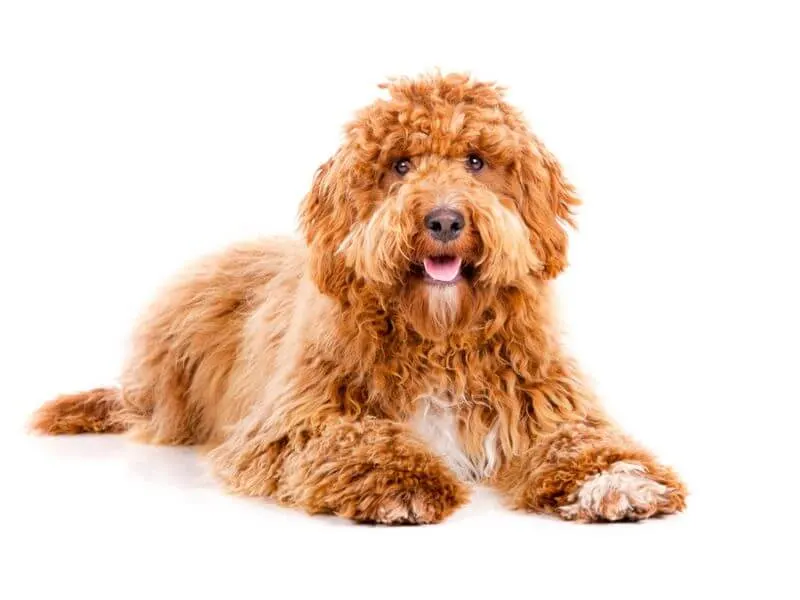
The amount of grooming that an Irish Doodle requires depends a lot on the type of coat that they inherited from their parents.
Irish Doodle coats that resemble Poodle coats typically don’t shed much or at all. However they still require regular brushing multiple times a week to eliminate tangles and matted hair.
Coats that are wavy and sleek like that of an Irish Setter, tend to shed more and also require frequent brushing.
Based on the length of the hair, it may also need to be trimmed by a groomer every 6-8 weeks to keep it in good shape.
How often should you bathe an Irish Doodle?
Frequent bathing can irritate the skin of an Irish Doodle so try to bathe your Irish Doodle just a few times each year.
Roughly once every 3-4 months is ideal, but occasionally they may need to be bathed more frequently.
Are Irish Doodles hypoallergenic?

Irish Doodles are typically medium to low shedders and are suitable for some people with mild allergies.
However, the type of coat that the individual dog has is inherited from its parents and just how hypoallergenic it is can be difficult to determine until the dog is fully grown.
Generally speaking, the F1B Irish Doodles have coats that are more similar to Poodles, which means they shed considerably less and are more suitable for people with allergies.
Irish Doodles from first generation mixes (F1 Irish Doodles) may have coats that resemble that of the hypoallergenic single layer Poodle parent or the non-hypoallergenic double coat of an Irish Setter parent.
It is always a good idea to consult medical, as well as veterinary professionals about hypoallergenic dog breeds, before you purchase a four legged friend.
These professionals can usually point you in the right direction of a suitable breed for your specific allergies.
Do Irish Doodles shed a lot?
Irish Doodles typically have medium to low shedding levels.
Depending on the generation, the degree of shedding dogs experience can vary.
Generally F1 Irish Doodles shed more than F1B Irish Doodles for example, which is why the latter is favored by people with mild allergies.
How long do Irish Doodles live for?

Irish Doodle life expectancy generally ranges between 10-15 years, depending on the dog. This is pretty typical life expectancy for medium sized dogs.
The Irish Doodle mini form may tend to live longer with a typical life expectancy closer to 15 years.
While Irish Doodles are generally a healthy breed, particularly the F1 generation, they do tend to suffer from some health problems.
Are Irish Doodles healthy?
Irish Doodles sometimes suffer from hip dysplasia and bloat. Other Irish Doodle health concerns induce eye and skin diseases, as well as epilepsy.
Regular vet check ups and necessary tests are essential to make sure your Irish Doodle stays healthy.
What do Irish Doodles eat?
Irish Doodles require good quality dog food to ensure that all of their nutritional needs are being fulfilled.
As the size, as well as gender, age and activity level of the dog determines the amount of food a dog should be given, it is important that you discuss food portions with your vet.
Irish Doodles will eat more than Mini Irish Doodles so it is important to make sure that your dog is getting the right amounts of food and not being put at risk of becoming overweight.
How much exercise do Irish Doodles need?
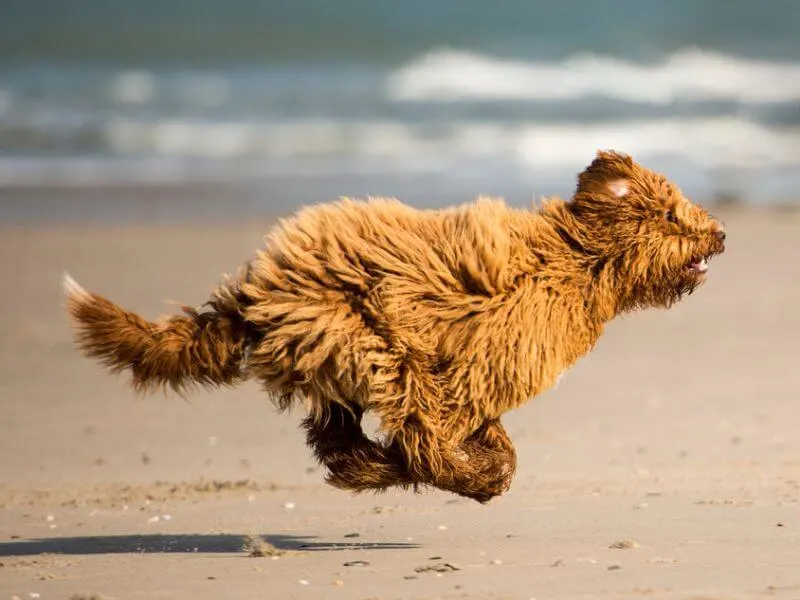
As energetic dogs, Irish Doodles need 1-2 hours a day of exercise to stay balanced and healthy.
They enjoy a wide range of sporting activities and will gladly accompany their owners on walks, jogs, hikes, swims and cycling trips.
These smart dogs also enjoy exercises and activities that stimulate their mental capacity and therefore perform well in canine sports such as agility, obedience and rally trials.
Dogs that do not get sufficient exercise on a daily basis are likely to become depressed and destructive, as well as obese.
It is essential that Irish Doodle owners realize the considerable amount of time that needs to be devoted to Irish Doodles in terms of exercise and maintenance on a daily basis before committing to getting one.
Do Irish Doodles like to swim?
Many Irish Doodles really enjoy swimming, which is not surprising given their ancestry.
The Poodle is a type of water dog and is usually an excellent swimmer. Irish Setters were generally bred with Irish physical traits required for varied terrain in Ireland.
Some of the upland hunting areas are quite boggy and marsh, so the Irish Setter would also need to get its feet wet from time to time.
If you would like to introduce your Irish Doodle to water, it is best to do so gradually to ensure that it is a positive experience for the dog.
Always keep an eye out to make sure that the water and weather conditions are safe for swimming.
Is an Irish Doodle a smart dog?
Irish Doodles are very intelligent dogs that are quick to learn and also quick to get bored if the task does not stimulate or entertain them enough.
Like the Irish Setter, the Irish Doodle tends not to forget the things and tricks that it has learned, regardless of whether they are good behaviors or not so desirable ones.
Be sure to start early with training to avoid as many training mishaps as possible!
Is it easy to train an Irish Doodle?
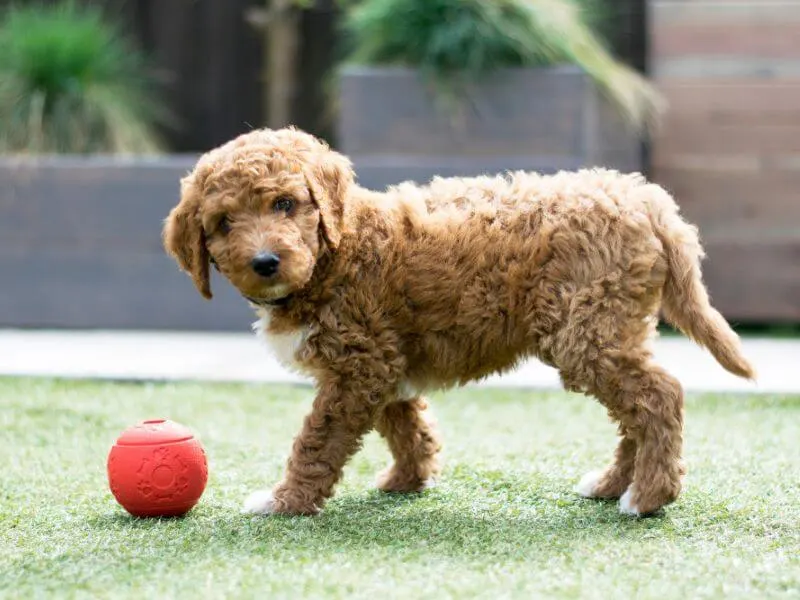
While Irish Doodles are very intelligent, they can be a bit tricky to train.
They pick up good and bad habits quickly and constantly require new input to avoid getting bored.
Irish Setters show many of the same traits, while generally Poodles are easier to train.
Starting to train an Irish Doodle at an early age will help set clear boundaries for the dog for life.
It is also a good idea to get them socialized with strangers, children and other dogs and pets from an early age to ensure they can be confident in a wide range of different circumstances.
Irish Doodles need a calm and consistent trainer that offers them plenty of stimulating ways to learn how to behave and be disciplined.
Lots of patience is required and this is not a task for everyone.
Positive reinforcement helps to reaffirm desired behaviors and should be preferred to harsh criticism, which tends to have a more detrimental effect on this sensitive dog breed.
Irish Doodles Temperament and Personality
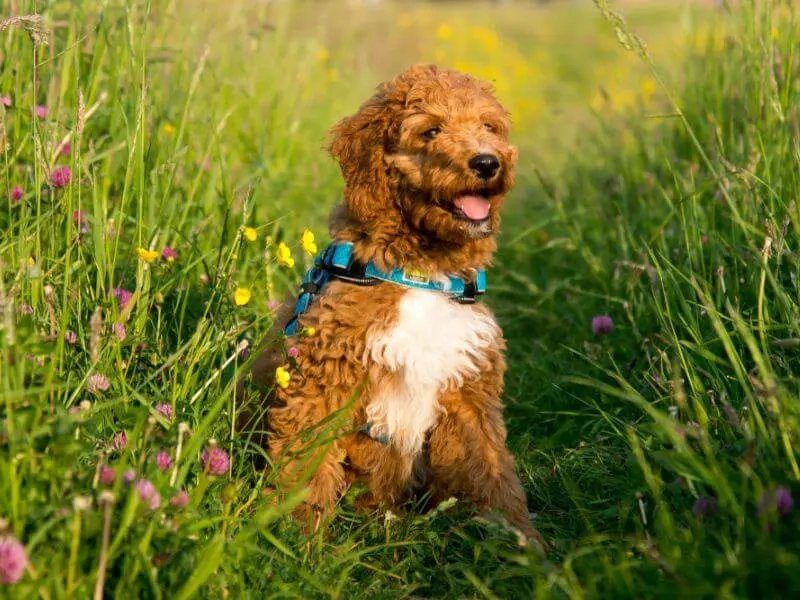
Irish Doodles are playful and energetic.
They thoroughly enjoy being included in activities and family life and thrive on company with people.
As highly intelligent dogs, they love to learn new things and are open to trying new things.
The Mini Irish Doodle temperament is very similar to that of the Standard Irish Doodle.
Is an Irish Doodle a good first dog?
It is important to weigh up the Irish Doodle pros and cons, especially if you are not experienced with owning and handling a dog.
Irish Doodles are friendly and lovable, but they can be challenging to train. If you are someone with lots of patience and can invest the time and energy to calming and consistently train your Irish Doodle, then it may be a dog for you.
Other serious considerations that you should keep in mind before opting for an Irish Doodle is whether you have sufficient time to cover the exercise and maintenance requirements of an Irish Doodle.
Are Irish Doodles good family dogs?
Active families are the perfect fit for an Irish Doodle.
They enjoy lots of exercise, as well as company and in a family they are likely to get both.
The friendly character of the Irish Doodle, in addition to its ability to get along with other pets helps to cement the family friendly characteristics of this type of dog even more.
Are Irish Doodles good with kids?

Irish Doodles are generally better suited to families with older kids, rather than young ones.
First of all, the size of a standard Irish Doodle may overwhelm younger kids and as they are quite energetic and playful, there is definitely likely to be some level of wild play, the rough and tumble might be too much for little ones.
Can an Irish Doodle be left alone?
It is not generally advised to leave Irish Doodles alone for long amounts of time.
Without company, Irish Doodles tend to get loney and may suffer from separation anxiety. The symptoms of this may show as excessive barking or other destructive tendencies.
Do Irish Doodles bark a lot?
Irish Doodles are not usually known for being excessively noisy and don’t tend to bark a lot.
Are Irish Doodles cuddly?

Yes, Irish Doodles are very cuddly and enjoy social contact so plenty of rubs and tickles are (usually) very welcome.
The coat type of the Irish Doodle will either be wavy, shaggy or curly depending on what the dog inherited.
While it is sometimes silky, like an Irish Setter, it is definitely fuller in volume and typically soft.
Are Irish Doodles aggressive?
No, a well balanced Irish Doodle is not usually aggressive.
Irish Doodles are generally good natured and friendly, which is just one of the reasons why they are not good guard dogs.
Are Irish Doodles good watch dogs?
While Irish Doodles are not ideal dogs if you need a guard dog, their alert and attentive nature is well suited to being watch dogs.
You can rely on these dogs to announce the arrival of a stranger to the home.
Friend or foe are usually greeted in the same friendly manner, which is typical of the temperament of Irish Doodles.
Are Irish Doodles good with other dogs?

In general, Irish Doodles get on well with other dogs, so at least in theory it is possible to have more than one dog in the home.
Exposure to other dogs from an early age helps with the socialization process and can help to ensure a higher level of success.
Are Irish Doodles good with cats?
While many Irish Doodles get on well with cats, it does tend to depend a little on the individual dog.
Irish Doodles that grow up with cats from a young age and are well socialized are less likely to cause problems with cats.
It is worth remembering that the ancestors of the Irish Doodle, the Irish Setter and the Poodle, were used as hunting dogs especially for wild fowl so there is probably some instinctive prey drive still within the Irish Doodle.
It is probably not a good idea to have an Irish Doodle and a pet bird…
Irish Doodle Breeders
Reputable dog breeders are extremely important.
If you are looking for a specific breed of dog, you need to do your homework as there are many breeders out there that do a suboptimal job and unfortunately there are also a lot of scams.
There are a few good rules to go by that are the same for Irish Doodles as for all other dog breeds.
The Kennel Club has a good list of general questions to prepare to ask the breeder and examples of the types of questions to ask during the visit.
Tip: Why not contact some veterinary clinics to see if they are aware of good Irish Doodle Breeders, they can sometimes help put you in contact with the right people.
Irish Doodle Puppies for Sale
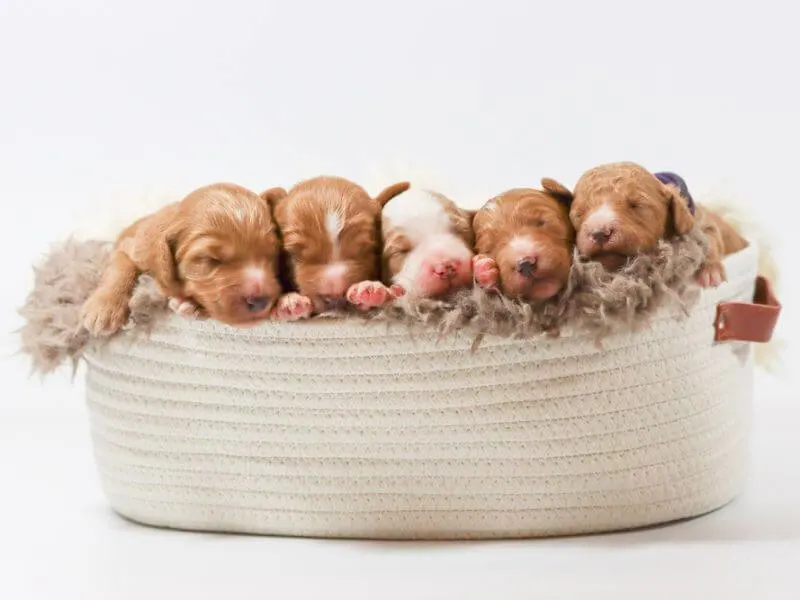
When it comes to looking into ads for Irish Doodle puppies or Mini Irish Doodle puppies for sale, there are several things that you should keep in mind.
You want to be able to visit the dog breeder and see the puppies, their mother and the conditions that they were raised in before purchasing the dog.
As well as having the opportunity to ask the breeder a lot of important questions, the breed will also be able to ask you questions and if it is a good breeder, determine your suitability for this dog breed and an individual puppy.
An experienced, knowledgeable breeder will be able to find a suitable home to fit the character type of the dog and not just hurry through with a sale.
A Word of Caution about Irish Doodle Breeders
Irish Doodles, along with all of the Doodle breeds (the Golden Doodle and Labra Doodles) Care undoubtedly very cute and popular.
There are many websites available online that offer good deals that sound too good to be true. Please be wary.
You want to make sure that the breeder is a reputable one.
Offers to ship your dog to you, might sound convenient especially if you live far away, but it probably isn’t the best for the dog and it doesn’t allow you to visit the breeder, view the mother and the condition that the dogs grew up in.
It is important to make sure to do your research and make sure that the Irish Doodle breeder you opt for is one that has the welfare of their animals as their top priority and wants to ensure that they get the best homes.
This same advice can also be applied when purchasing other dog breeds.
Irish Doodle Price
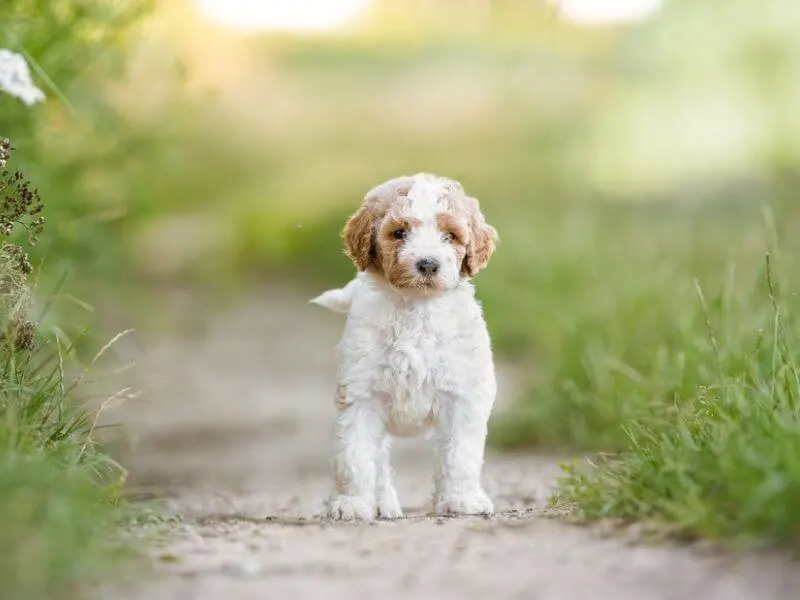
The price of an Irish Doodle can vary considerably depending on several factors.
The coloring of the dog is likely to determine some of the price.
At the lower end of the Irish Doodle Price scale is the apricot colored Irish Doodle, which is most common and can be found for about US$1400.
The red Irish Doodles being more expensive (ca. US$1800). Special white markings up the price even more.
It is not uncommon for the Irish Doodle for sale price to be considerably higher (ca. US$3000) so it is important to shop around in order to know exactly what you are getting, what health check and guarantees that the breeder covers.
As Mini Irish Doodles typically come in smaller litter, their cost is typically even higher (minimum of ca. US$2200).
The Origin of the Irish Setter and Poodle Mix
The exact origin of the Irish Doodle is hard to trace down. It is thought that the Irish Doodle was developed as one of the recent designer dogs in the last two decades or so in the United States.
The Irish connection to the Irish Doodle comes from its purebred Irish Setter history.
History of the Irish Setter
The Irish Setter is a medium-sized, solid red chestnut or mahogany colored dog that was developed in Ireland as a gun dog for hunting wild fowl.
They are thought to have first developed around the 17th century, although records are difficult to come by.
Originally, the setter dogs in Ireland were a mix of white with red patches.
Over time, certain wealthy families of dog breeders in Ireland who kept these dogs in large numbers tended to focus on particular traits in the dogs.
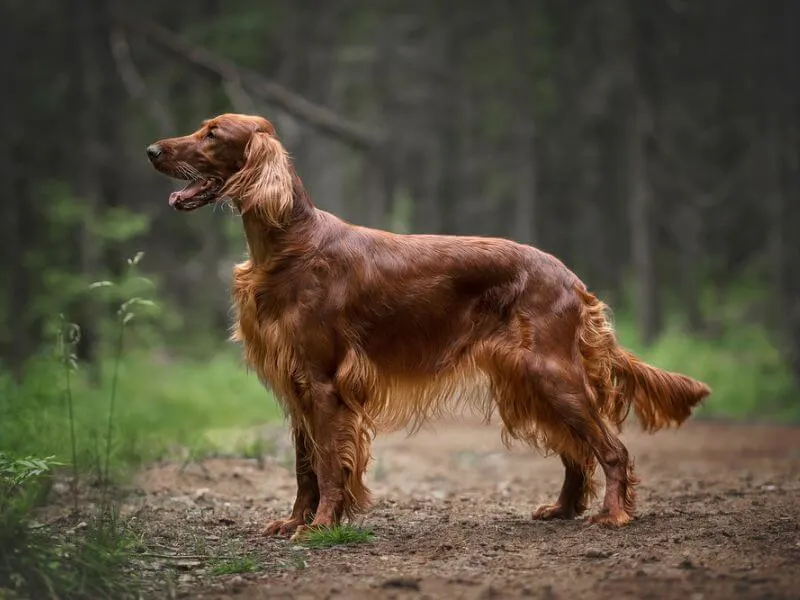
The Rossmore family of Monaghan bred red and white setters, while the Earl of Enniskillen became famous for their solid red setters.
Around the 1870s and 1880s, the popularity of the solid red setter began to rise rapidly.
This dog, which was called the Irish Red Setter, was officially recognized as a unique breed called the “Irish Setter” in the 1870s. In 1878 the American Kennel Club also recognized the breed.
As the breeders for the Irish Setter focused largely on the appearance of the dog, the hunting traits that the dog were bred for for generations, became less relevant.
In contrast, the largely forgotten Irish Red and White Setter was threatened with extinction during the rapid rise to fame of its cousin.
The breeders who fought hard to preserve this breed, focused their efforts not on the aesthetic, but on the hunting ability of this dog.
It was only as recently as 2009 that this breed was recognized by the American Kennel Club. Ironically, almost a century after its descendant, the Irish Setter was recognized.
The Irish Setter is now the most popular of all native Irish dog breeds world wide. Miniature Irish Setters are a smaller variation and not that common.
If you want to know more about the Irish Setter, then read the Breed Guide to Irish Setters or get an introduction via the Guide to Irish Dog Breeds.
History of Poodles
Poodles are a type of water dog that are thought to have developed in Germany, although some people argue that the dog originated in France.
One strong reason to believe that the Poodle has German origins stems from its name.
There are strong similarities between the low German verb of “puddeln” meaning to splash and the name “Poodle”.
As a water dog, the main task of the Poodle would have been to retrieve wild fowl from that water like other breeds such as the Golden Retriever and Labrador.
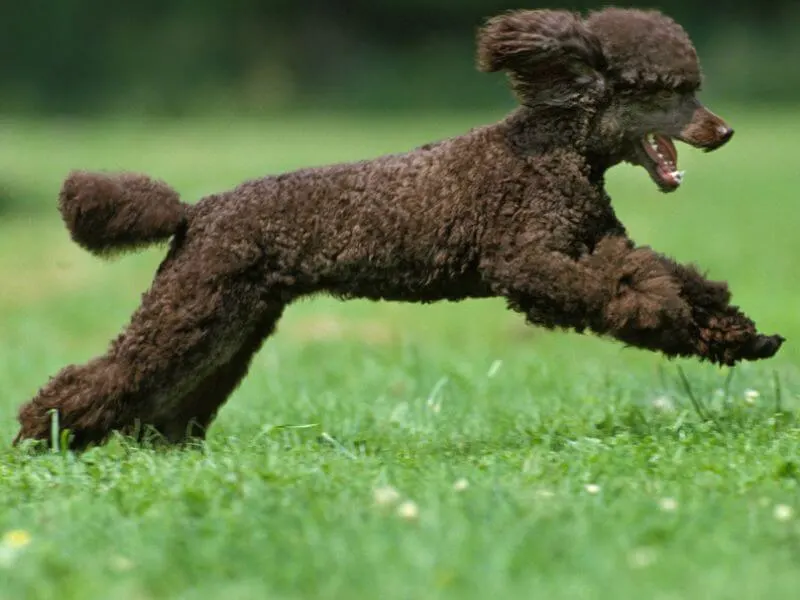
Intelligent, easy to train and eager to please, Poodles are a very popular dog breed that come in various different sizes.
Three of these sizes are recognized by the American Kennel Club (Standard Poodle, Miniature Poodle and Toy Poodle).
It is thought that the origin of the Miniature Poodle developed through their use in circuses in France during the 19th century.
The Toy Poodle is even smaller than the Miniature Poodle. Regardless of the size of the Poodle they are all considered the same breed by the American Kennel Club and have the same breed standard.
While extravagant Poodle hairstyles are what commonly comes to mind when one thinks of this dog breed, what few people know is that the original unusual hair styles were functional.
They were designed to keep the Poodle’s joints and extremities warm when swimming in water, but hamper the dog’s swimming ability.
Poodles have a single layer coat that is typically a non-shedding coat and is considered to be hypoallergenic.
Irish Setter Poodle Mix
When you cross Irish Setters with a Poodle this results in an F1 Irish Doodle, with traits from each parent.
When first generation Irish Doodles (F1) are bred with purebred Poodles, the result is F1B Irish Doodles.
These are genetically more similar to Poodles, less likely to shed and are generally more suitable for people with allergies.
Other names that the Poodle Irish Setter mix is referred to include: Irish Poodles, Irish Poodle mix, Irish Setter Doodles, Irish Doodle Setters, Irish Setter Poos and Irish Poos. Take your pick, whichever you prefer!
Irish Doodle Companion Dogs
Irish Doodles make great companion dogs.
They enjoy the company of their owners, whether it is being active and out and about or cuddling up with them on the sofa after a busy day.
Their need for company makes them more sensitive and affected by separation though so it is important to ensure that they do not get lonely and get the required level of input every day.
Native Irish Dog Breeds
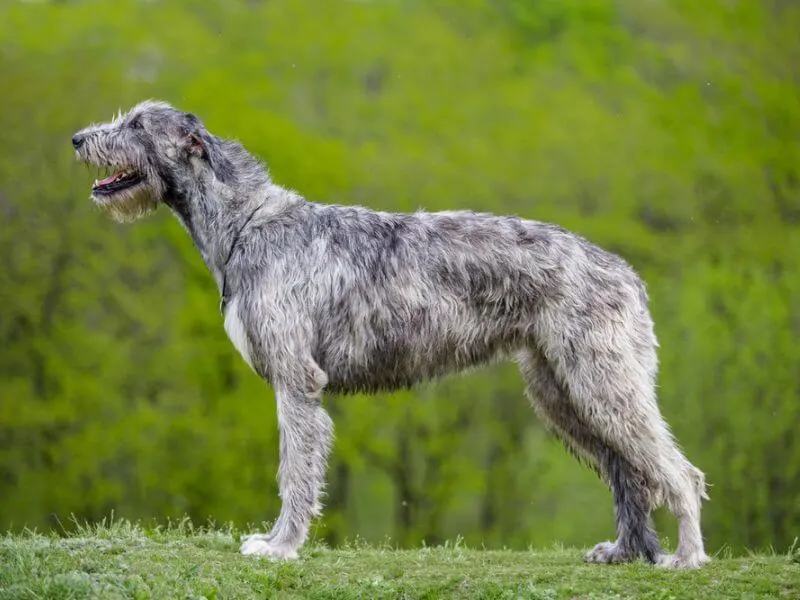
In total Ireland has 9 recognised dog breeds, these distinctive dog breeds have been developed over time to suit varying purposes, largely to do with hunting in rural Ireland in the past.
Each one of these unique breeds has its own characteristics, Irish traits, charm and interesting history.
From the legendary tales of the Irish Wolfhound in Irish mythology to the war efforts of the Irish Terrier in World War I, there is lots to discover about these dog breeds.
If you would like to find out more about native Irish dog breeds, then you can check out the Guide to Irish Dog Breeds. For more in depth information, please check the individual dog posts.
- Irish Setter
- Irish Red and White Setter
- Irish Water Spaniel
- Irish Wolfhound
- Kerry Beagle
- Irish Terrier
- Kerry Blue Terrier
- Irish Soft Coated Wheaten Terrier
- Glen of Imaal Terrier
This article may contain affiliate links. If you click on one of these we may receive a small commission at no extra cost to you. Thank you for your support.
Please note that this article is only for general information purposes about the Irish Doodle and should not be used as a substitute for canine health information, as well as medical and dog care advice from veterinary specialists.

(Irish Nature Expert and Celtic Enthusiast from Ireland)
Emer Walker, founder of LetsGoIreland.com, is a Cork native with profound expertise in Irish nature and ecology. Holding a PhD in Restoration Ecology and backed by extensive research in ecological sciences, she’s delved deep into Ireland’s natural wonders, from its rugged landscapes to its serene beaches. Emer’s passion also encompasses Celtic art and traditions. As a true authority on Ireland’s natural and cultural heritage, she invites readers through LetsGoIreland.com to immerse themselves in the authentic Irish experience.
